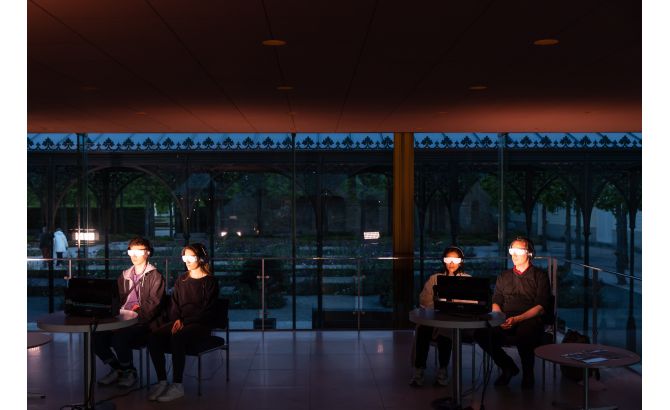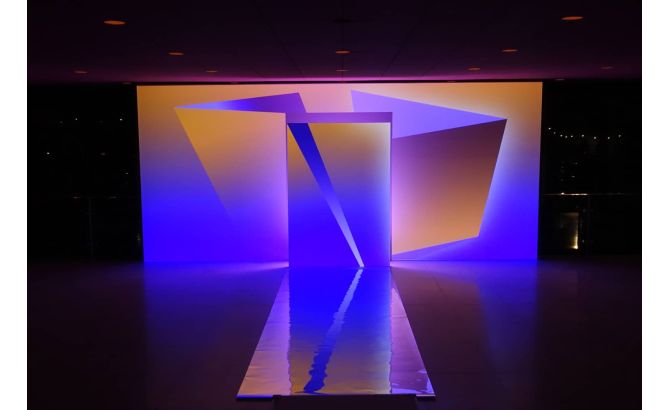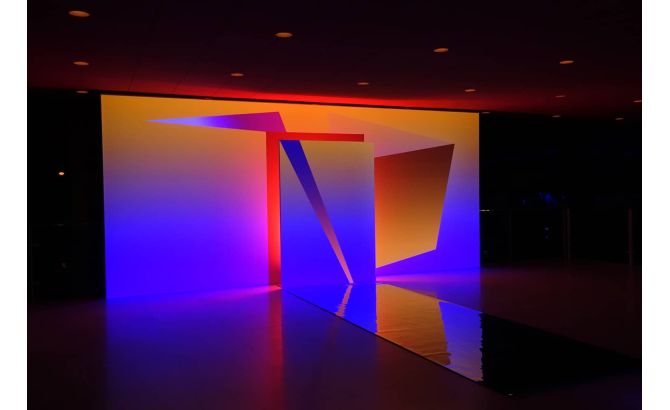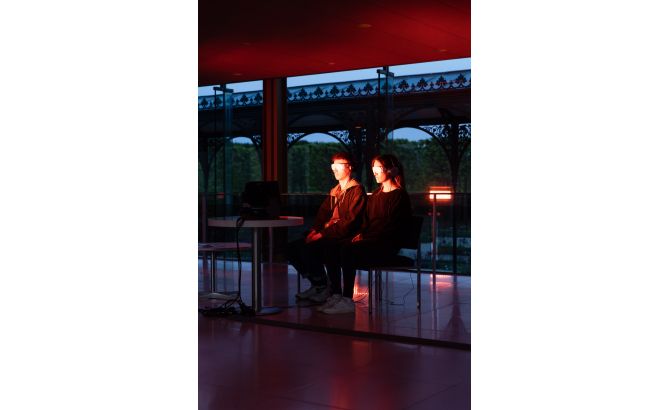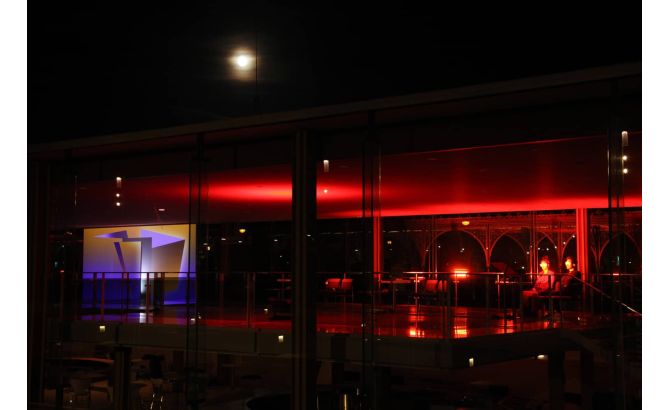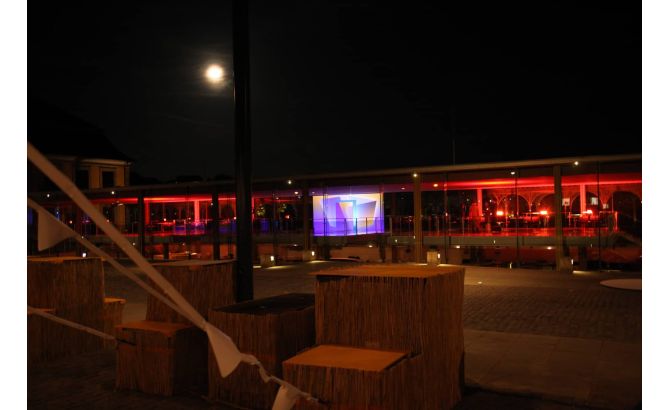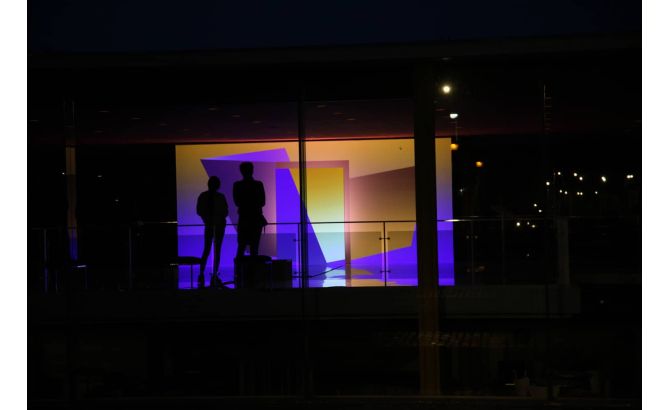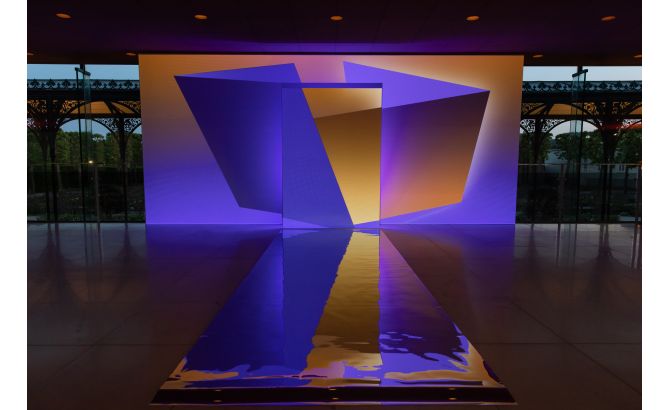Looking-Glass House is a new work by Andrea Božić and Julia Willms in collaboration with the moon: an audio-visual installation for the Arne Jacobsen Foyer at the baroque Herrenhausen Gardens taking place every evening of the festival after the sunset. It takes the visitors on a parcour of spaces from outside the building to an immersive environment inside it and back outside to the night sky.
Especially for the occasion of the KunstFestSpiele Herrenhausen, Božić and Willms have collaborated with the moon's Metonic cycle: a cycle where the Moon returns to exactly the same place in the night sky and against the same backdrop of the stars every 19 years.
They have made 1965 Night Sky Replica: the exact same night sky above Hannover as it was in the year 1965, the year the construction of the Arne Jacobsen Foyer began. Throughout the festival, the moon will pass through the exact same phases as it did 57 years ago, against the same backdrop of star constellations, making a precise replica of the night sky in 1965. Growing from a waxing gibbon to a full moon to then disappear from the skies on the closing night of the festival as new moon. The visitors can observe 1965 Night Sky Replica from any point outdoors.
With a special event: Blood-Orange Moon (live performance) - a total eclipse of the Supermoon above Hannover in the early morning of the 16th of May.
The video-light installation Civil Twilight - Choreography for 450 nm and 600 nm inside the Arne Jacobsen Foyer brings the palette of the night sky colours into the modernist glass-house building, expanding its architectural inversion of the inside outside spaces and the play of mirroring and reflections.
It works with the colours of the night sky, a deep indigo-violet-blue and deep orange-red ranges, the shortest and longest wavelengths visible to human eye, creating a continuous movement with the twilight night sky.
The video-light installation features a cube-like shape in constant movement that plays with the perception of colour and shape. It combines infrathin layers of colour light projected across several surfaces, creating a perceptual continuum between a 2D video image and 3D projection screens, the shape constantly affected by a flux of merging colour fields.
Also inside the AJ Foyer, the visitors can enter an immersive installation Through the Looking Glasses based on the Ganzfeld effect. They wear a pair of specially designed non-see-through glasses, against which a range of slowly cross-fading colours is projected. Wearing a set of headphones, they listen to white noise based on granular synthesis. The eye sees uniform colour fields with no recognizable spatial border or shape, and the ear hears no recognizable sound related to the environment but a continuous noise wave. ‘Looking outside’ becomes ‘looking inside’. The visitors are taken to ‘no space’: a sensory immersion within this no-space of colour and noise, a highly affective state. Visitors who experience the piece are visible to passers-by as a part of the exhibit, while also being totally immersed in a different environment and cut off from the outside.
About Ganzfeld effect: ‘When our brains are starved of any stimuli after staring at any featureless, uninterrupted field even for a few seconds, it triggers the Ganzfeld effect, which in German means ‘total field’ or ‘entire field’. The ancient Greeks and Tibetans engaged in a similar process by entering dark caverns to receive insights from their subconscious minds, or from the otherworldly realms. This phenomenon has been experienced by arctic explorers staring at featureless expanses of white snow, prisoners in dark cells (termed ‘prisoner’s cinema”), astronauts, pilots, and miners trapped in underground caverns who end up having visions of apparitions.’
https://www.psychreg.org/ganzfeld-effect/
A training based on Ganzfeld effect is undergone by astronauts preparing for travel in outer space.
Works on view:
1965 Night Sky Replica by Andrea Božić
Durational installation, daily, from sunset to sunrise
Moon, Earth, star constellations, Metonic cycle
2022
Civil Twilight by Andrea Božić & Julia Willms
Choreography for 450 nm and 600 nm
Video-light installation
Video projection, light, mirror floor
14 min loop
2022
Through the Looking Glasses by Andrea Božić, Robert Pravda, Julia Willms
Audio-visual installation
Several persons installation, white glasses, light, sound
4 min loop
2022
Blood-Orange Moon by Andrea Božić
Live performance
Moon, Earth, Sun, weather
2022
Andrea Božić and Julia Willms’ video installation The Cube can be seen in the Städtische Galerie KUBUS.
About the festival:
The KunstFestSpiele Herrenhausen in Hanover is an annual international and interdisciplinary festival in which music plays a central role. For the 13th edition of the festival, artistic director Ingo Metzmacher and the dramaturgy have again put together a diverse program that transcends genre boundaries and invites the audience to unique artistic experiences. From 12 May to 29 May 29 2022, the KunstFestSpiele will present musical theater, performances, concerts, dance and theater performances, and installations by international artists. Some of the works on display have been specially commissioned and developed for the venues of the KunstFestSpiele Herrenhausen.
Preview: Friday, 13 May — 21.00 hrs
Opening: Saturday, 14 May 2022 — 21 hrs
Exhibition: 14.05.2022 – 23.05.22, daily from 21.00-23.00 hrs*
Arne Jacobsen Foyer
Herrenhäuser Str. 3
30419 Hanover, Germany
Artist Talk: Sunday, 29. May 2022, 14:00 hrs
Anne Prenzler and Rainer Hofmann concerse with Andrea Božić and Julia Willms at KUBUS (Free admission, in English)
Credits:
Concept and audio-visual installation Andrea Božić and Julia Willms animation and editing Julia Willms sound Robert Pravda technical development Paul Beumer and Erik Denneborg software development Nikzad Arabshahi
Through the Looking Glasses installation, which is part of the Looking-Glass House, is made by Julia Willms, Andrea Božić and Robert Pravda | TILT
Photo's: Julia Willms and Helge Krückeberg
